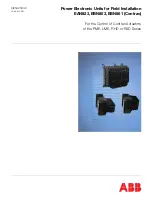
SECTION 2: GETTING STARTED
11
REI
OSC-5000E
SECTION 2: GETTING STARTED
The best method to becoming proficient with the OSCOR is to study the manual while
using the equipment and to attend REI training classes. Information about training classes
is provided at
www.reiusa.net
.
As previously stated, the OSCOR can be powered using 3 methods: internal battery, AC
(115/230 VAC), and DC (12-18 VDC). It is recommended that AC power be used for
most operations. This ensures that the unit is grounded for improved sensitivity and that
the battery system is maintained.
WARNING:
Be sure the voltage selector switch is set to the
proper input voltage (115 or 230 VAC) before operation.
The OSCOR can be controlled directly using the built-in OSCOR keypad, or by the
OSCOR PC (OPC) Interface software. The OPC software provides additional functions
and capabilities to further improve the reliability of a sweep. The following sections
provide some introductory exercises followed by detailed descriptions of Manual and
Automatic operation. The OSCOR OPC Software is covered in the OPC software
manual.
The main sections that describe OSCOR functionality are:
•
SECTION 3: OSCOR MANUAL OPERATION (page 27)
•
SECTION 4: OSCOR AUTOMATIC OPERATION (page 69)
•
SECTION 5: DETECTING SOPHISTICATED TRANSMITTERS (page 83)
While this entire manual should be studied before attempting as weep, particular
attention should be paid to these sections.
The section entitled SECTION 6: CONDUCTING A SWEEP that begins on page 91
provides recommended guidelines for using the OSCOR to perform a sweep. However,
an understanding of the previous sections is crucial to a successful operation of the
OSCOR.
Do not attempt to memorize all of the step-by-step procedures. These are provided as a
guide to assist you in learning the available functions. With a good understanding of the
functions, you can develop procedures to customize the operation to specific needs and
issues.
Notes:
•
Due to the related nature of many functions, you will find some duplication of
descriptions and instructions.
•
All instructions are printed in
Italics
.
•
Bold words in instructions represent the button to push.
•
Please pay close attention to the special “
NOTE
:”, “
TECHNICAL NOTE
:”, and
“
WARNING
” cited throughout the manual.
















































